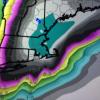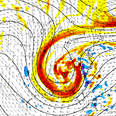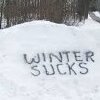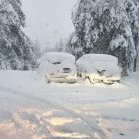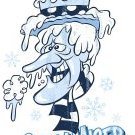
Isotherm
Members-
Posts
7,930 -
Joined
-
Last visited
About Isotherm

- Currently Viewing Topic: March 2025
- Birthday January 1
Contact Methods
-
Website URL
http://www.lightinthestorm.com/
Profile Information
-
Gender
Male
-
Location:
New Jersey
Recent Profile Visitors
16,887 profile views
-
Regarding the seasonal prognostication discourse, as someone who has been engaging in biannual long range outlooks (summer, winter) since 2006-07, with a high degree of success, I would state that the outcome which occurred this winter as it pertains to the AO domain in particular, (to a lesser extent the NAO), is very rare statistically speaking, wrt the indicators I analyze. The type of atmospheric alteration which occurred Nov-Dec and at the magnitude at which it occurred, was a nigh impossibility when considering the 1950-2020 indicator data. I expected the PNA+ outcome (Dec/Jan +, Feb -) and EPO+, and thought the NAO would go + Dec, - Jan, +Feb (but the DJF will be negative, a miss), and the AO severely negative was a major derogation from expectations. My formula that I utilize which incorporates several disparate variables and prognosticates the NAO at circa 90% success did not foresee this, thus, this AO-NAO outcome to me was a true curveball in the sense that the indicators actually supported an opposite average DJF outcome for the modality of the NAO-AO. I've determined upon analysis that the salient variables which emerged, in my view at least, could have only been potentially foreseen if I had waited another 10 days or so to write my winter outlook. There were red flags I noticed later in November that suggested the AO may not be positive for the winter. Overall, a very fascinating winter from the standpoint of atmospheric and oceanic nina-esque and nino-esque imprints. The SSW was a wildcard which disturbed the timing of the temperature progression, although the winter will average warmer than normal as I thought. I would hypothesize that a displacement outcome rather than a split may have allowed the colder January I thought would occur, but we ended up with a split, and a rather benign pattern for our -NAO month in January. The major stratospheric warming event was another highly unusual outcome given certain precursor signals, but the indicators did favor a perturbed and weak tropospheric vortex for January.
-
OBS and nowcast Thursday morning 2/18 - 11PM Friday 2/19/21
Isotherm replied to wdrag's topic in New York City Metro
Indeed, it was. The stratospheric warming wildcard was fascinating, as if that evolved more-so in a displacement rather than split fashion, January likely would have been colder. Retrospectively, the NAO will be near neutral December, negative January, and positive February. But the SSW prevented us from receiving the cold/snow results until later. I thought we'd have most of our snow this winter within a month stretch, but was off on the timing by about 15 days. The magnitude of the snowy period was more impressive than anticipated due to the -AO/blocking this winter. -
OBS and nowcast Thursday morning 2/18 - 11PM Friday 2/19/21
Isotherm replied to wdrag's topic in New York City Metro
Thanks and almost - this event brings me to 38.9" on the season (31.1" since Jan 31st). Today was certainly the definition of a CNJ/Monmouth jackpot. It appears C-NJ/N-NJ, at least through today, has been one of the most favored regions snowfall wise relative to normal, in the DCA-BOS corridor. Our stretch of snow cover was 8 days in December, and Jan 31st-present thus far. -
OBS and nowcast Thursday morning 2/18 - 11PM Friday 2/19/21
Isotherm replied to wdrag's topic in New York City Metro
9.8" now total here. -
OBS and nowcast Thursday morning 2/18 - 11PM Friday 2/19/21
Isotherm replied to wdrag's topic in New York City Metro
8.8" here, likely final total - Colts Neck, Monmouth County [reported to NWS via trained spotter ID]. This brings us to 37.9" on the season. -
OBS and nowcast Thursday morning 2/18 - 11PM Friday 2/19/21
Isotherm replied to wdrag's topic in New York City Metro
6.5" here so far - interior Monmouth. -
Currently 12.2F with ground ice fog here -- a unique, rare phenomenon, induced by the deep, fresh snow cover. It was "freezing fog", but note that typically under 14F it is termed "ice fog" as the water droplets cannot remain in liquid forum.
-
Obs and nowcast Super Bowl Sunday 4A-6P Feb 7, 2021
Isotherm replied to wdrag's topic in New York City Metro
5.1" total. 27.1" YTD. Current depth: 11". -
My Winter Outlook 2020-21
Isotherm replied to Isotherm's topic in Weather Forecasting and Discussion
One note on snowfall: Snowfall is invariably the most stochastic, capricious and therefore most difficult variable to prognosticate from the long range, which is why I assign more weighting to temperature departures than snowfall at final verification. That said, the snowfall tally through 2/5/2021 has NYC at 28.0", slightly above my seasonal snowfall range. It is almost certain that this value will be increased, via, at least, light or moderate opportunities in the coming 10 days. Boston, currently around 22", has a ways to go to arrive at my range of 40-48", though that is still within the range of outcomes, certainly. The Mid-Atlantic cities are nearing my seasonal projections at this time. We will see how the remainder of this period progresses. However, for those certainly in the NYC area, it appears certain that a "positive" snowfall error will be occurring this winter, namely, more snowfall than forecasted. NYC will likely get into the 30s as far as snowfall. The evolution of the mid-month threat is subject to a number of different permutations and mechanisms. The equatorward/southwestward degradation of the block toward the Pacific is not ideal, as it could invite height rises in the Southeast US. Further to that, the MJO is somewhat out of phase and may tend to force SE-ridge resistance in the means. Contemporaneously the TPV will press from the north, as the SSW mediated block decays to its northwest. Overall, a highly convoluted and difficult to prognosticate variables. However, the rapid multi-standard deviation rise in the AO & NAO invite another large precipitation event opportunity. The PNA may not be as conducive this window, however, and that must be monitored. I'm not nearly as optimistic about this window as I was for Jan 31-Feb 2 along the Northeast/Mid-Atlantic coast, due in part to the more favorable mechanics of the block degradation in Jan 31-Feb 2. That said, Feb 12-14 is a window to monitor in the East. -
My Winter Outlook 2020-21
Isotherm replied to Isotherm's topic in Weather Forecasting and Discussion
Indeed. While there is significant uncertainty as to the pace at which the NAO neutralizes in the medium to long range, I believe it's high probability as this point that DJF will average negative for NAO (barring an anomalous positive episode from mid month through the end of Feb, which isn't out of the question). The NAO finished -1.11 for January and -0.3 for December. January was expected, but the inter-monthly duration of the NAO was unexpected. The DJF NAO miss will go down as my first NAO formula miss in about a decade. And of course the AO domain, likely the most glaring aberration from the indicators I've quite frankly ever seen. The QBO finished +10 for January, continued strongly westerly. And while that in and of itself is not the sole determinant, there were other robust indicators pre-season that strongly suggested a neutral or positive AO mean winter. I have been speculating/hypothesizing as to provenance -- the 2020 Australian fire induced aerosol dispersal may have been a factor in changing things up, possibly in concert with record low Arctic sea ice. But I think more likely the former. Regardless, the mean circulation flow altered significantly in the Arctic once December began. As to February temperature departures, as you delineated in a recent post, it is possible the East Coast still finishes warmer than normal, depending upon the second half. The core of the cold will clearly be centered in the N Rockies-N Plains for the first half of the month. Overall forecasted temperature departures DJF still may fare very well; we will revisit that at the end of Feb. Snowfall -- New England looking good for a SWFE threat next week (potentially). And we'll need to monitor the window around mid-month as the blocking structure degrades. -
13.8" total here, likely total. An additional 1.7" fell overnight/this morning. Year to date seasonal is 21.3".
- 1,932 replies
-
- heavy snow
- wind damage
-
(and 1 more)
Tagged with:
-
12.1" here now. Solid low-end MECS territory, if it were to be over. I thought we would receive 14-18" total (that band clearly developed 15 miles farther north, favoring N/C NJ into NYC). However, it is possible we pick up an additional 1-3".
- 1,932 replies
-
- heavy snow
- wind damage
-
(and 1 more)
Tagged with:
-
A major winter-storm is evolving across the Mid-Atlantic and Northeast, as signaled by the macro-scale proxies which suggest that a meteorological show will be displayed over the coming 12-36 hours. The appearance of this storm as much as two weeks ago was foreshadowed by the multi-standard deviation height field alterations over key domain spaces (specifically the PNA/NAO vicissitudes). As a result, this will likely be the largest, widespread winter storm since March 2018. Estimated snowfall for various locations: Atlantic City, NJ: < 2" Point Pleasant, NJ: 5-10" Trenton, NJ: 14-18" Freehold: 14-18" - locally higher New Brunswick: 14-18" - locally higher New York City, NY: 14-18" - locally higher Newark, NJ: 14-18" - locally higher Philadelphia, PA: 6-12" Sussex, NJ: 8-15" "Jackpot" totals will occur via the juxtaposition of initial overrunning, maintenance of frozen p-type during the energy transfer, and the secondary redevelopment induced enhancement. This region will be approximately 1.5 degrees latitude north of the z850 low path, and N/W of the z700 low path -- NYC on the northeastern side, Morristown on the northern side, southwestward to near the Delaware River, then extending southeastward to Freehold on the southeastern side. I expect that there will likely be some 18"+ reports within the delineated zone.
- 2,426 replies
-
- 9
-

-

-
- heavy snow
- ice pellets
-
(and 3 more)
Tagged with:
-
My Winter Outlook 2020-21
Isotherm replied to Isotherm's topic in Weather Forecasting and Discussion
Monitoring the recovery of the z10-z50 stratospheric vortices as well as the subseasonal/MJO signal which will play a greater role in the month of February. At least, from the NAO perspective, it will flip positive early Feb (following the major storm/phase change threat, which finally showed up at the tail end of the Jan +PNA/-NAO pattern). Then the NAO may dip negative again in the Feb 5-9 time frame, but potentially only ephemerally. Coherent MJO 6-7 w/ magnitude is a +NAO signal, and depending upon the pace at which the SPV recovers, that may add adjunctively to a neutral or + NAO. The AO domain, I think may be a bit different, and that domain space will clearly go down as a miss this winter. The AO will probably average neutral to negative for Feb, if only by virtue of both residual +GP strat heights initially, but then the coherent MJO 6-7 assist will drive poleward EPO ridging into the Arctic domain. So the AO heights will receive assist from the Pacific induced intraseasonal alterations. My thinking at this time is the MJO expeditiously weakens in coherency beyond P7, so most of Feb should still feature the fairly robust SE-ridging in the means, and a colder Rockies/N Plains structure as forecasted. Another player on the field is that Feb will have legitimate arctic cold on the North American side, now that the SSW is over. So the cold shots that do slide through the Northeast US will be quite strong in February. Fascinating winter overall, and from a LR forecasting point of view, particularly on the AO domain, a very rare outcome in terms of opposing certain indicators. I still think February will probably be a snowier than normal month for most of New England (although warmer than normal in the means). SNE coast points southward will be dependent upon the extent of countervailing blocking.


